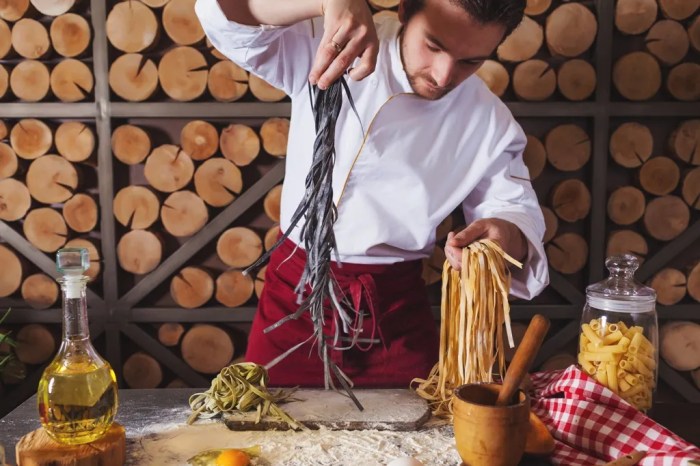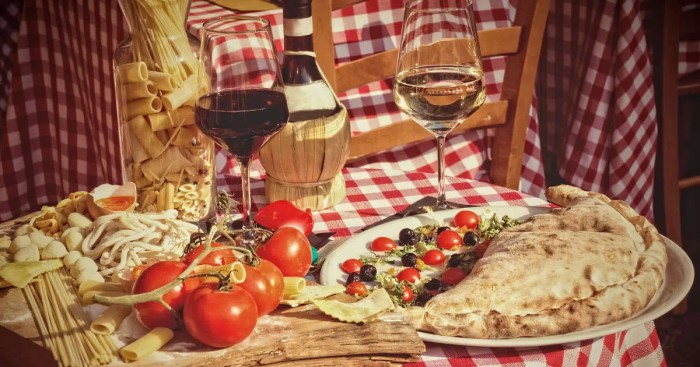
Embark on a culinary adventure unlike any other. Culinary tours and cooking vacations offer a unique blend of travel and gastronomy, promising unforgettable experiences for food enthusiasts. Whether you dream of exploring vineyards in Tuscany, mastering the art of pasta-making in Italy, or immersing yourself in the vibrant spice markets of Marrakech, these journeys cater to a diverse range of tastes and interests.
This exploration delves into the diverse offerings, planning considerations, and the overall enriching experience these unique vacations provide.
From leisurely wine tours to intensive cooking classes, the possibilities are endless. The appeal lies not only in the delicious food but also in the cultural immersion, the chance to connect with local communities, and the creation of lasting memories. This guide aims to provide a comprehensive overview, assisting you in planning your own delectable escape.
Defining Culinary Tours and Cooking Vacations

Culinary travel offers a delectable blend of exploration and education, appealing to both seasoned gourmands and curious novices. Understanding the nuances between culinary tours and cooking vacations is key to selecting the perfect gastronomic getaway. While both involve food and travel, their focus and experiences differ significantly.Culinary tours and cooking vacations are both forms of experiential travel centered around food and drink, but they differ in their primary focus.
Culinary tours emphasize exploration and discovery of a region’s culinary landscape, often involving visits to markets, vineyards, restaurants, and food producers. Cooking vacations, conversely, center around hands-on culinary experiences, with significant time dedicated to learning and practicing specific cooking techniques and recipes.
Types of Culinary Tours
A wide array of culinary tour options caters to diverse interests and preferences. These tours often combine sightseeing with gastronomic exploration, offering a holistic travel experience.
Examples include wine tours, focusing on vineyard visits, wine tastings, and often including meals paired with the wines; regional food tours, showcasing the unique culinary traditions of a specific area, from local markets to traditional restaurants; and themed cooking classes, offering focused instruction on a particular cuisine or cooking style (e.g., pasta-making in Italy, sushi-making in Japan).
Typical Itinerary Components of a Cooking Vacation
A typical cooking vacation itinerary blends immersive culinary experiences with cultural exploration.
Common components include daily cooking classes led by experienced chefs, visits to local markets to source fresh ingredients, guided tours of culinary landmarks (e.g., cheese factories, olive groves), meals featuring dishes prepared during the classes, and opportunities for cultural immersion, such as exploring local towns and historical sites. The duration of these vacations typically ranges from a long weekend to a full week or more, depending on the chosen program.
Comparison of Culinary Travel Options
The following table compares the cost, duration, and activities of different culinary travel options. Prices are estimates and can vary significantly based on location, season, and the level of luxury.
| Type of Culinary Travel | Typical Duration | Estimated Cost (per person) | Typical Activities |
|---|---|---|---|
| Short Wine Tour (1 day) | 1 day | $100 – $300 | Vineyard visits, wine tastings, light lunch |
| Regional Food Tour (3 days/2 nights) | 3 days | $500 – $1500 | Market visits, restaurant meals, cooking demonstrations, sightseeing |
| Cooking Vacation (7 days/6 nights) | 7 days | $2000 – $5000 | Daily cooking classes, market visits, ingredient sourcing, cultural excursions, meals |
| Themed Cooking Class (Weekend) | 2-3 days | $500 – $1000 | Intensive cooking classes, meals featuring prepared dishes, possible cultural activity |
The Culinary Tour Experience

Embarking on a culinary tour is more than just a vacation; it’s an immersive journey into the heart of a region’s culture, history, and gastronomy. These tours offer a unique blend of sightseeing, hands-on learning, and delectable dining experiences, creating memories that linger long after the trip concludes. Participants can expect a dynamic and engaging exploration of food and its cultural significance.A typical culinary tour involves a carefully curated itinerary that balances structured activities with opportunities for spontaneous exploration.
The experience often includes visits to vibrant local markets brimming with fresh produce, aromatic spices, and unique regional ingredients. These markets offer a chance to interact with local vendors, learn about seasonal specialties, and even purchase ingredients for later use in cooking classes. Cooking classes themselves are a highlight, providing hands-on instruction in preparing traditional dishes under the guidance of expert chefs.
Finally, restaurant visits allow participants to sample the region’s culinary offerings in authentic settings, from casual eateries to fine-dining establishments.
Cooking Class Learning Methods
Culinary tours employ diverse teaching methods to cater to various learning styles. Demonstration-based classes allow participants to observe expert chefs preparing dishes, followed by a step-by-step replication. Interactive classes encourage active participation, with each participant involved in every stage of the cooking process. Finally, some tours incorporate a blend of these methods, starting with a demonstration followed by hands-on practice.
The goal is to provide a comprehensive understanding of techniques, ingredients, and the overall culinary process.
Group Tours versus Private Culinary Experiences
Group culinary tours offer a cost-effective and sociable way to experience a destination’s cuisine. Sharing the experience with fellow food enthusiasts fosters camaraderie and creates opportunities for shared learning and discussion. However, private culinary tours provide a more personalized and flexible experience. These tours can be tailored to individual preferences and dietary needs, allowing for a more intimate exploration of the region’s culinary scene.
The choice depends on personal preferences and travel style; group tours offer affordability and social interaction, while private tours provide customization and exclusivity.
Sample 5-Day Culinary Tour Itinerary
A well-structured itinerary is crucial for a successful culinary tour. The following example demonstrates a possible 5-day itinerary focusing on Italian cuisine in Tuscany.
This itinerary balances cooking classes, market visits, and restaurant experiences to provide a comprehensive culinary immersion.
- Day 1: Arrival in Florence & Oltrarno Market Visit: Arrive in Florence, check into your hotel, and embark on an afternoon exploration of the vibrant Oltrarno Market. Enjoy an aperitivo at a local wine bar followed by dinner at a traditional Trattoria.
- Day 2: Pasta-Making Class & Florentine Steak Dinner: Participate in a hands-on pasta-making class, learning to create various pasta shapes from scratch. Enjoy lunch featuring your creations. In the evening, savor a delicious Florentine steak dinner at a renowned steakhouse.
- Day 3: Tuscan Countryside Excursion & Wine Tasting: Explore the picturesque Tuscan countryside with a visit to a local vineyard. Enjoy a wine tasting session paired with regional cheeses and cured meats. Dine at an agriturismo (farm stay) experiencing authentic Tuscan home-style cooking.
- Day 4: Pizza-Making Class & Culinary Market Tour: Learn the art of pizza-making in a fun and interactive class. Enjoy lunch featuring your freshly made pizzas. In the afternoon, explore a local culinary market, selecting ingredients for a self-prepared dinner.
- Day 5: Departure: Enjoy a final leisurely breakfast before departing from Florence, taking with you the memories and culinary skills acquired during your tour.
Whether you’re a seasoned foodie or a curious traveler, culinary tours and cooking vacations present an exceptional opportunity to expand your palate, broaden your cultural understanding, and create memories that will last a lifetime. The diverse options available ensure there’s a perfect culinary adventure waiting for everyone, promising a delightful blend of exploration, education, and pure gastronomic delight. So, pack your bags, sharpen your knives (metaphorically, unless you’re taking cooking classes!), and prepare for a truly unforgettable journey.
Popular Questions
What’s the difference between a culinary tour and a cooking vacation?
Culinary tours typically involve visits to markets, restaurants, and wineries, with a focus on tasting and experiencing local cuisine. Cooking vacations, on the other hand, emphasize hands-on cooking classes and often include more intensive instruction.
Are culinary tours suitable for solo travelers?
Absolutely! Many culinary tours cater to solo travelers, offering a chance to meet like-minded individuals and share experiences. Some operators even offer single supplements or discounts.
What’s the best time of year to go on a culinary tour?
The ideal time depends on the destination. Research the local climate and harvest seasons to find the best time for experiencing the freshest ingredients and most pleasant weather.
How much should I budget for a culinary tour?
Costs vary greatly depending on the destination, duration, and type of tour. Expect to pay anywhere from a few hundred to several thousand dollars. Consider factors like flights, accommodation, activities, and meals when budgeting.





